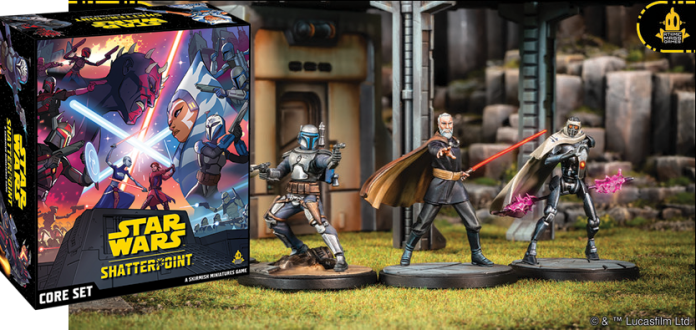Hey, it’s Summer. Your resident Star Wars: Armada bitch. I’m launching Goonhammer’s coverage of this anticipated new game. At least until people who are more enthusiastic about Ground Wars take over, so that I can return to my flagship.
Atomic Mass Games (AMG) announced a new tabletop miniatures game last November and we’re now getting substantial info about it. I’m here to recap what Shatterpoint is about, and what we know.
Shatterwhat?
Like all things in Star Wars, a shatterpoint is an actual Force phenomenon/plot device. Perhaps the most famous portrayal is in the eponymous novel focused on Mace Windu. The book was quite well-received. Now in 2023, AMG has built its skirmish game on this premise: that a battle can start in any way, and end in any outcome. Since its announcement, Shatterpoint has drawn immediate comparisons to their wildly loved Marvel: Crisis Protocol. I don’t blame them. The parallels are right there.
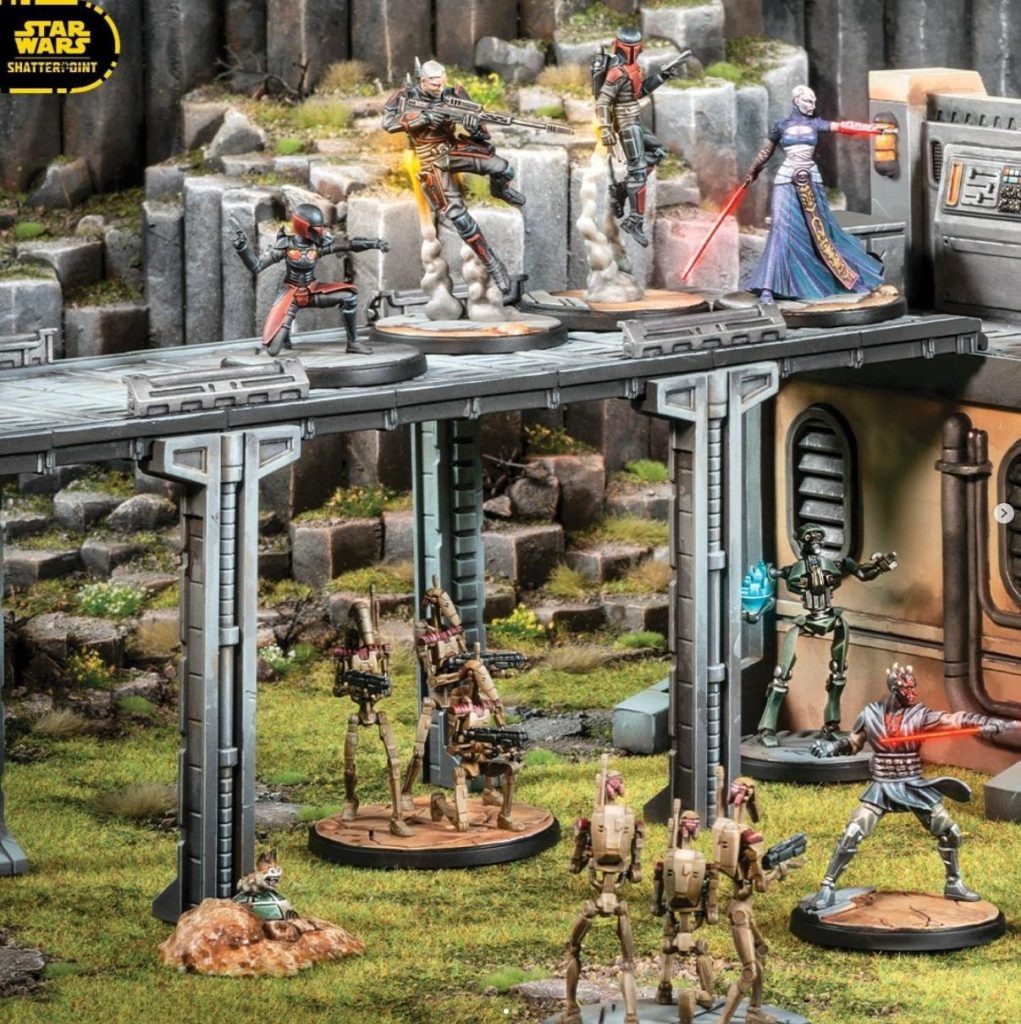
Star Wars: Shatterpoint
Publisher: Atomic Mass Games (Marvel: Crisis Protocol; Star Wars: Legion; Star Wars: X-Wing; Star Wars: Armada)
Release: June 2023
Battle size: Small squads composed of characters and generic troops
Model scale: 40mm
Key gameplay elements: Character abilities, dense terrain, and verticality
Core set MSRP: Approximately $165
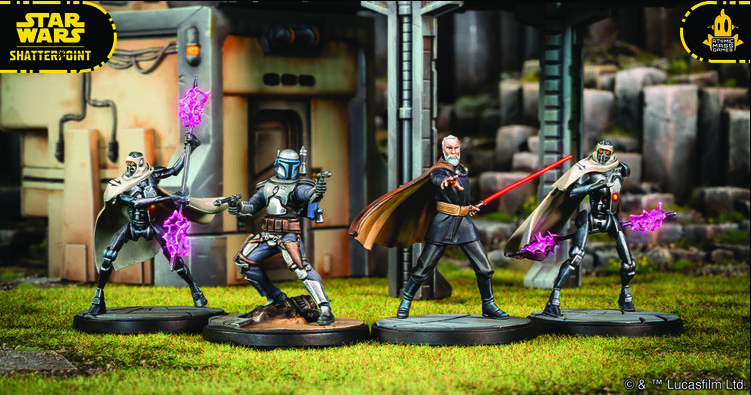
Shatterpoint comes in at a chunky 40mm scale – much larger than most wargames. Games Workshop trends toward 28mm Heroic scale, and historical games can run far smaller. Shatterpoint shares its scale with Marvel: Crisis Protocol, and this appears successful for the kind of combat being depicted: squad-level engagements with a focus on close-combat and special abilities. The large scale also encourages painting interesting miniatures without increasing the difficulty with small details through small details.
The game’s squad-based combat involves teams of models working independently. Each unit sits on a single base, and only the weakest units (B1 Battle Droids and similar) have multiple models crowded onto one base. This is in contrast to Star Wars: Legion, which runs standard games at platoon size (a few infantry squads, some leaders and vehicles), or 40K tournament games at company size (combined arms battles with numerous infantry models, vehicles, monsters, and super-heavy units). Although we don’t know how the game plays, its scale, contents and pedigree as a homegrown AMG product imply an adherence to Crisis Protocol’s fast, fun action.
Terrain interactions will be a core component of Shatterpoint. This isn’t just extrapolating from Crisis Protocol. It’s been repeatedly noted in developer releases, and we’ll see them put their plastic where their mouths are (please don’t) in the core set unboxing. One point that’s been mentioned a lot is verticality, which is probably going to play well with assorted Force-users and agile units like commando droids.
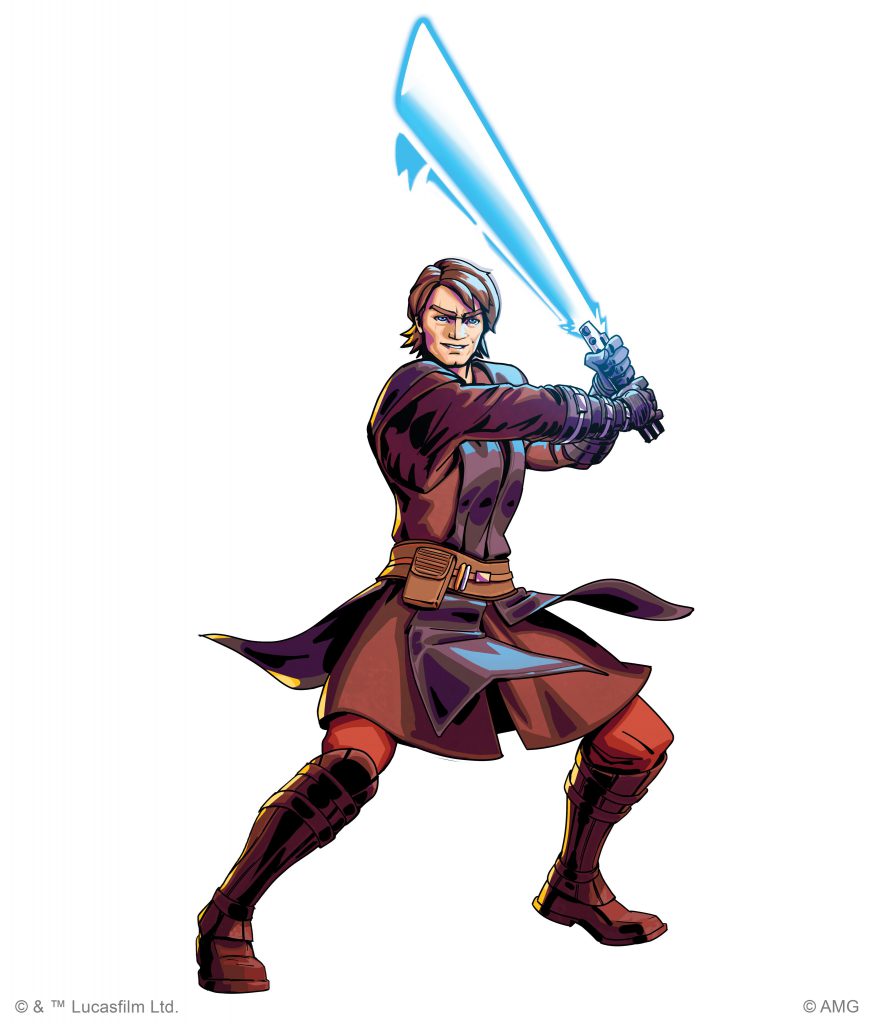
Notably, this game does not have predefined factions. As far as we know, any characters can form a squad with each other irrespective of the lore. Before you panic about the Darth Maul + Commander Cody + Count Dooku meta, this can still be balanced. Crisis Protocol specifies ‘affiliations’ for units that give bonuses when the majority of a list is drawn from one affiliation. This encourages building to lore and within ‘factional’ limits, but does not enforce it. I’m still iffy about applying this to Star Wars, which has such a clear-cut divide in morality, but we should encourage innovation when we see it, I suppose. One special game mechanic that was showcased was a Struggle Tracker, a tug-of-war style method of tracking your side’s mission progress. More details are forthcoming, but the short version is that if you can push your Momentum all the way to the end of the tracker, you win the mission. I suspect your opponent will have opinions about this.
If the pattern holds, then you can expect a slick skirmish game with easily understood rules. Expect alternating or semi-random activations (all AMG properties do it this way), terrain-based play, and big models. Fantasy Flight Games and AMG properties are all big on punch-out cardboard tokens and trackers, custom movement tools and unique dice (many of which have been seen).

I wish to see the babies.
I’m with you. The reason Goonhammer is launching its coverage now is because AMG recently had a livestreamed unboxing video of the game’s core set. We got a good, albeit table-level look at the game’s launch contents. They… didn’t have a birds-eye camera for the unboxing, which was frustrating to viewer and presenter alike.

Core Set Contents
16 units in 4 themed squads
Anakin Skywalker and Clones
Anakin Skywalker
Captain Rex (CC-7567)
2x Clone Troopers (501st)
Ahsoka Tano and Clan Kryze
Ahsoka Tano
Bo-Katan Kryze
2x Mandalorians (Clan Kryze)
Lord Maul and Super Commandos
Lord Maul
Gar Saxon
2x Mandalorian Super Commandos
Asajj Ventress and Droids
Asajj Ventress
Kalani
2x B1 Battle Droids (3 models per base)
An impressive amount of terrain
At least two full bags of sprues to build a table suitable for playing Shatterpoint. It’s actually about two-and-a-half bags of terrain, with models and bases mixed in.

Core rulebook
Of course there’s a rulebook. The physical rulebook is glossy and features a comic-book/animated style art cover similar to the box art. Previous experience suggests that the rulebook will also be available as a free PDF. Pay attention, Games Workshop.
Gameplay cards
Fantasy Flight Games and Atomic Mass Games properties lean heavily on pre-printed cards for tracking unit stats, objectives, gear, and special rules. Shatterpoint is no exception, and features cards in at least two sizes. Characters and units are depicted in the same animated style as the box art.
Play aids
A pack of custom dice. Custom dice often play very well when integrated into a well-designed ruleset, but they are also a way for publishers to nickel-and-dime players on game accessories because they’re the sole provider.
Cardboard tokens and trackers. Another hallmark of Fantasy Flight Games and Atomic Mass Games: sheets of sturdy, coated punch-out cardboard. I know from experience that you can even waterlog their cards and cardboard, and it will dry out and remain functional. The ink doesn’t rapidly bleed in contact with water.
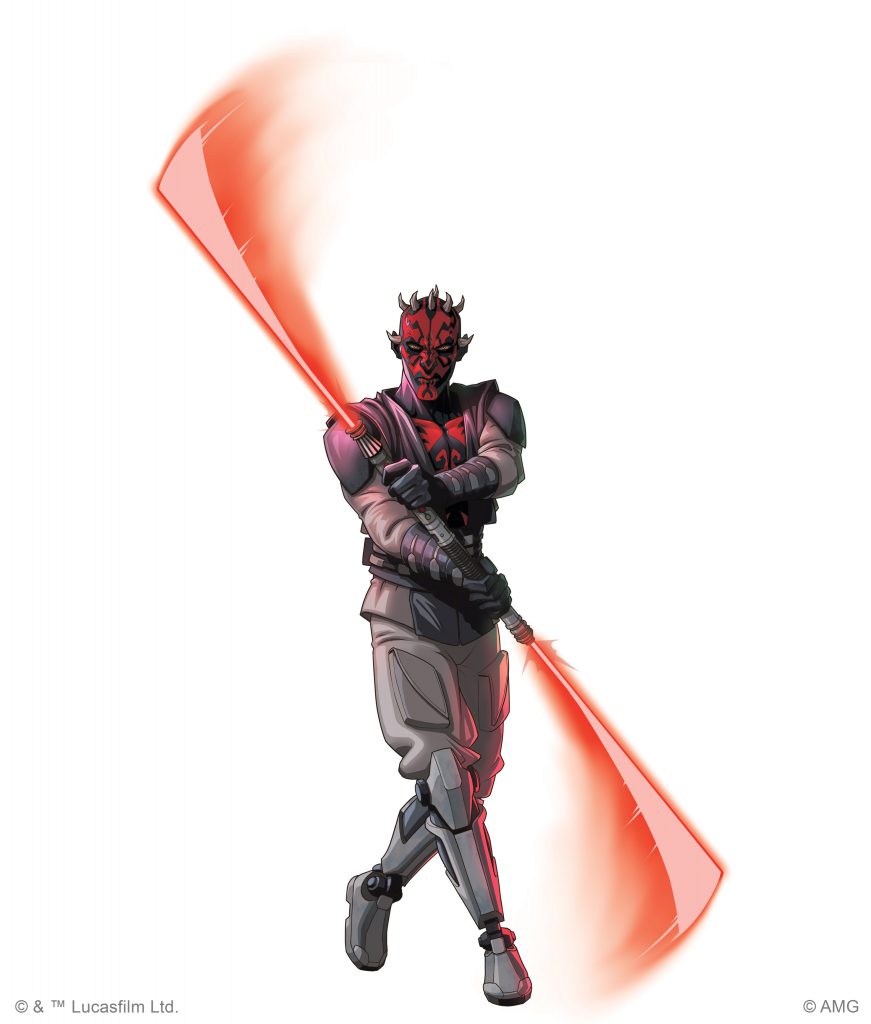
Summer’s thoughts
Let me disclose some biases here:
I have never given a shit about comic book hero wargames. I also don’t care about small skirmishes. I utterly resent Marvel: Crisis Protocol for potentially sucking resources from Star Wars: Armada (my favourite game). I dislike animation-style art, and large miniatures make me unreasonably uncomfortable. I prefer my miniatures to be mini.
My main thought when watching the unboxing was that… this is one of the beefiest starter boxes I’ve seen. It looks like enough to play a competent game and not feel left out.
And you know what? That’s sad. It’s sad that the current landscape of wargaming impresses me with a functional core set. We’ve moved so far from the era when a starter or core could host a full-sized game that we treat it like it’s special. We’re so deep into the microtransaction-inspired world of unit expansions and packs and terrain kits and upgrade frames and accessory boxes, that core sets aren’t even a functional game anymore. They’re a taster designed to get you hooked and commit to buying expansion packs.
Star Wars Armada has this problem – the Empire half of the core set doesn’t constitute a fleet in the barest sense. For a fleet warfare game. Oh, X-Wing? The game of fighter squad combat? The Rebels get one fighter. Not a squad, buddy. Games Workshop puts out generational Warhammer 40 000 core sets stuffed with escalating ranges of impressive models and rulebooks, but the days of quality terrain in mainline 40K products are past. Today, it’s either a squad-based game with comprehensive terrain, or an army-based game with none. The sun set on Battle for Macragge in 2008. I was 15 years old in 2008. Armada and X-Wing can get away with not having terrain because their game scenery uses cardboard punch-outs. But new 40K and Age of Sigmar players get the new game experience of improvised household goods, a cardboard box, or game store tables.
Don’t even get me started on the inability to play a standard-sized game out of a core set. You need to double your starting expenditure in Armada to reach a ‘standard’ game. X-Wing? Games Workshop? Aim even higher. A while ago, someone on Discord impressed me when they mentioned that Aeronautica Imperialist had one of the best starter sets in recent history because players could field a standard match out-of-the-box.
I’ve never cared about games like Shatterpoint, but I recognise a strong start when I see it. The box comes with four squads for a game where players bring one squad to a standard match (as far as I know.). That’s four themed ‘armies’ inside the box. There are also no faction-locks, so you can start mixing and matching those models straight into your collection and future lists. At the very least, it’s enough models for four players to play a basic game, or two players to play super chunky games.
The terrain awes me. The publisher emphasised the importance of terrain in previews, and then they stuffed the box full of terrain. There’s far more scenery in here than there are models. The game calls for verticality, so they called out the large number of catwalks and gantries you can start with. Are there scenery expansions? Yeah, they’ve already announced them. But there’s a massive pile to start with. Only Kill Team comes close to this kind of commitment. I strongly admire Kill Team’s approach to making scenery important, and then filling a box with enough of it to play a comfortable game. I bought two Kill Team starter sets in different years just for the scenery. I still have Tau pathfinders rotting in a drawer unassembled – and they deserve it for being xenos. I came here for the Sector Imperialis.
Anyway.
I went into the unboxing stream and previews feeling… tepid. Even a little bitter that AMG was developing a whole new product while Star Wars: Armada lies neglected and X-Wing’s playerbase is in flames over poorly realised changes. I came out of it with a respect for AMG’s strengths, and how they’ve applied themselves. Their strengths are colourful, fun games built on skirmish gameplay. That’s why Crisis Protocol is great, and it’s clear that they’ve given the same capability to Shatterpoint. More importantly to me, I want this to give them the experience they need to reignite their other products. To give us the proverbial spark that will light the fire that will restore the Republic. This core set is an optimistic start to that. It looks like a core set that’s not just a taster, and I hope that turns out to be true. Time will tell.
Launching a new game is no easy endeavour, and even though I have strong opinions about the life support-state of Star Wars: Armada, I will always place my hope in a publisher that respects their source material, their theme, and their players. Shatterpoint kicks off in June, 2023. Stay tuned with Goonhammer for high-quality coverage and top-notch rants.
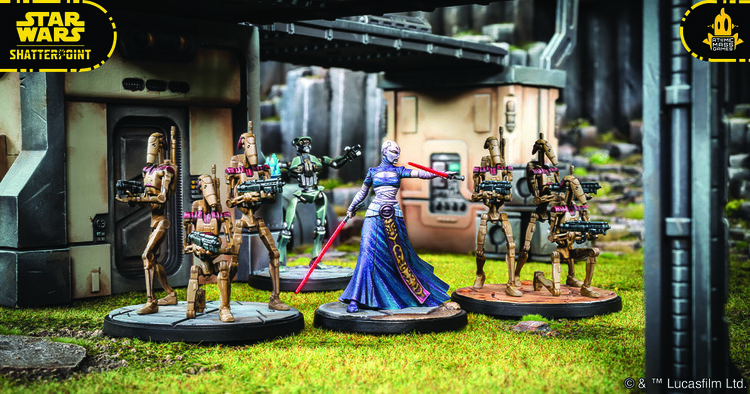
Have any questions or feedback? Drop us a note in the comments below or email us at contact@goonhammer.com.
